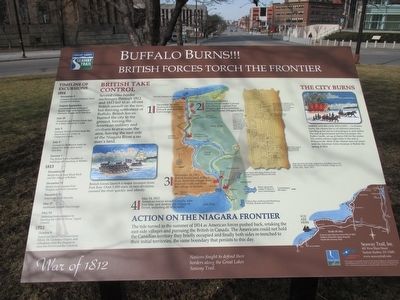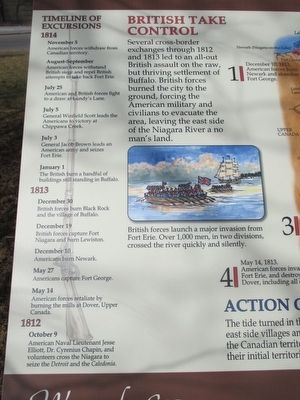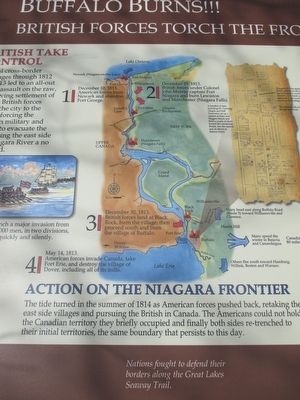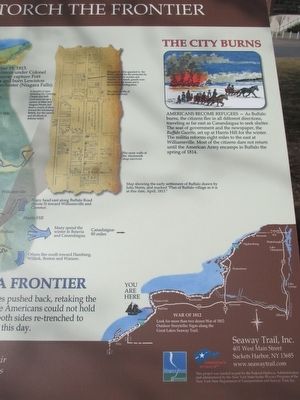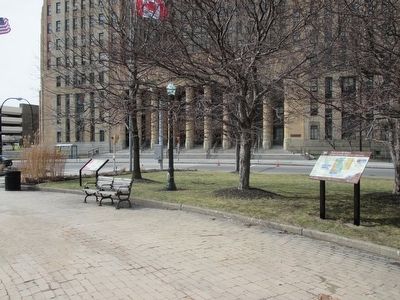Downtown in Buffalo in Erie County, New York — The American Northeast (Mid-Atlantic)
Buffalo Burns!!!
British Forces Torch the Frontier
— War of 1812 —
Timeline of Excursions
1814
November 5 American forces withdraw from Canadian territory.
August-September American forces withstand British siege and repel British attempts to take back Fort Erie.
July 25 American and British forces fight to a draw at Lundy's Lane
July 5 General Winfield Scott leads the Americans to victory at Chippawa Creek.
July 3 General Jacob Brown leads an American army and seizes Fort Erie.
January 1 The British burn a handful of buildings still standing in Buffalo.
1813
December 30 British forces burn Black Rock and the village of Buffalo.
December 19 Brtish forces capture Fort Niagara and burn Lewiston.
December 10 Americans burn Newark.
May 27 Americans capture Fort George.
May 14 [sic] Americans forces retaliate by burning the mills at Dover, Upper Canada.
1812
October 9 American Naval Lieutenant Jesse Elliott, Dr. Cyrenius Chapin, and volunteers cross the Niagara to seize the Detroit and the Caledonia.
British Take Control
Several cross-border exchanges through 1812 and 1813 led to an all-out British assault on the raw, but thriving settlement of Buffalo. British forces burned the city [sic] to the ground, forcing the American military and civilians to evacuate the area, leaving the east side of the Niagara River a no man's land.
[caption] British forces launch a major invasion from Fort Erie. Over 1,000 men, in two divisions, crossed the river quickly and silently.
1) December 10, 1813. American forces burn Newark and abandon Fort George.
2) December 19, 1813. British forces under Colonel John Murray capture Fort Niagara and burn Lewiston and Manchester (Niagara Falls).
3) Decemeber 30, 1813. British forces land at Black Rock, burn the village, then proceed south and burn the village of Buffalo.
A handful of men including Dr. Cyrenius Chapin and Seth Grosvenor set up a cannon at Main and Niagara Streets and fired a couple shots toward the advancing British, but the cannon and all efforts at defense failed.
Margaret St. John appealed to the British general for the protection he had promised to women and children. As a result, guards were stationed at her house and it survived the conflagration.
The stone walls of the jail survived.
The stone walls of the blacksmith shop survived.
Map showing the early settlement of Buffalo drawn by Juba Storrs, and marked "Plan of Buffalo village as it is at this date, April, 1813."
The City Burns
Americans Become Refugees - As Buffalo burns, the citizens flee in all different directions, traveling as far east as Canadaigua to seek shelter. The seat of government and the newspaper, the Buffalo Gazette, set up at Harris Hill for the winter. The militia reforms eight miles to the east at Williamsville. Most of the citizens dare not return until the American army encamps in Buffalo the spring of 1814.
Many head east along Buffalo Road (Route 5) toward Williamsville and Clarence.
Many spend the winter in Batavia and Canadaigua.
Others flee south toward Hamburg, Willink, Boston and Warsaw.
4) May 14, 1813 [sic]. American forces invade Canada, take Fort Erie, and destroy the village of Dover, including all of its mills.
Action in the Niagara Frontier
The tide turned in the summer of 1814 as American forces pushed back, retaking the east side villages and pursuing the British on Canada. The Americans could not hold the Canadian territory they briefly occupied and finally both sides re-trenched to their initial territories, the same boundary that persists to this day.
Nations fought to defend their borders along the Great Lakes Seaway Trail.
War of 1812. Look for more than two dozen War of 1812 Outdoor Storyteller Signs along the Great Lakes Seaway Trail.
Seaway Trail, Inc., 401 West Main Street, Sackets Harbor, NY 13685, www.seawaytrail.com America's Byways. This project was funded in part by the Federal Highway Administration and administered by the New York State Byways Program of the New York State Department of Transportation and Seaway Trail, Inc.
Erected by Seaway Trail, Inc.
Topics and series. This historical marker is listed in this topic list: War of 1812. In addition, it is included in the Great Lakes Seaway Trail National Scenic Byway series list. A significant historical date for this entry is December 30, 1813.
Location. 42° 53.2′ N, 78° 52.701′ W. Marker is in Buffalo, New York, in Erie County. It is in Downtown. Marker can be reached from the intersection of Niagara Square and Niagara Street. Marker is within Niagara Square, northwest quadrant, between the McKinley Monument and Niagara Street. Touch for map. Marker is at or near this postal address: 65 Niagara Square, Buffalo NY 14202, United States of America. Touch for directions.
Other nearby markers. At least 8 other markers are within walking distance of this marker. From Frontier to Major City / Buffalo City Hall (a few steps from this marker); Niagara Square (a few steps from this marker); From Social Center to Civic Center (a few steps from this marker); William McKinley (within shouting distance of this marker); "...With Liberty and Justice for All." (within shouting distance of this marker); Our Legacy of Abundant Water (within shouting distance of this marker); Samuel Manning Welch (about 400 feet away, measured in a direct line); Charles R. Turner (about 400 feet away). Touch for a list and map of all markers in Buffalo.
More about this marker. The May 1814 American invasion of Upper Canada is incorrectly dated 1813 on the marker timeline and in the text.
Credits. This page was last revised on February 16, 2023. It was originally submitted on March 1, 2016, by Anton Schwarzmueller of Wilson, New York. This page has been viewed 737 times since then and 39 times this year. Photos: 1, 2, 3, 4, 5. submitted on March 1, 2016, by Anton Schwarzmueller of Wilson, New York.
